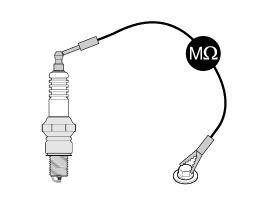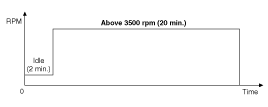Kia Cadenza: Ignition System / Spark Plug Repair procedures
Kia Cadenza YG 2016-2025 Service Manual / Engine Electrical System / Ignition System / Spark Plug Repair procedures
| Inspection |
| [On vehicle inspection] |
| 1. |
Accelerate the engine to about 3,000 rpm 3 times or more. |
| 2. |
Remove the spark plug. |
| 3. |
Check the spark plug visually.
If the electrode is dry, the spark plug is normal.
If the electrode is wet, check the damage and electrode gap as below. |
| [Component Inspection] |
| 1. |
Check the spark plug for any damage on its thread and insulator.
If there is damage, replace the spark plug. |
| 2. |
Check the electrode. Measure the insulation resistance with an ohmmeter.
If the resistance is less than the specified value, adjust the electrode gap.
|
| 3. |
Check the spark plug electrode gap.
If the gap is greater than the maximum, replace the spark plug.
|
| Cleaning |
The combustion temporarily becomes unstable, due to the aged
fuel and the carbon deposits accumulated on the spark plug(s) after
long-term storage.
| [1st Method] |
| 1. |
Start the engine and keep the engine running at idle for 2 minutes. |
| 2. |
Step on the accelerator pedal and hold it steady at 4500 rpm
with the shift lever in N position to warm up the engine until the
temperature of the engine coolant reaches 80°C. |
| 3. |
Keep the engine running at 2500~3000 rpm in the N position for 15 minutes.
|
| [2nd Method] |
|
| 1. |
Start the engine and keep the engine running at idle for 2 minutes. |
| 2. |
Drive the vehicle for over 20 minutes, keeping the engine speed above 3500 rpm.
|
| Removal |
| 1. |
Remove the ignition coil.
(Refer to Ignition System - "Ignition Coil") |
| 2. |
Using a spark plug wrench, remove the spark plug (A).
[Bank1]
[Bank2]
|
| Installation |
| 1. |
Install in the reverse order of removal.
|
 Spark Plug Specifications
Spark Plug Specifications
Specification
ItemSpecificationTypeSILZKR7B11Gap1.0 ~ 1.1 mm (0.0394 ~ 0.0433 in.)
...
 Charging System
Charging System
...
Other information:
Kia Cadenza YG 2016-2025 Service Manual: Repair procedures
Fuel Pressure Test (Low pressure system) 1. Release the residual pressure in fuel line. (Refer to the Fuel Delivery System - Repair Procedures - "Release Residual Pressure in Fuel Line"). When removing the fuel pump fuse, a Diagnostic Trouble Code (DTC) may occu ...
Kia Cadenza YG 2016-2025 Service Manual: Air Ventilation Seat Description and Operation
Description Using the blows power of FAN on seat, remove the moisture, sweat and warmth from occupants and surface of seats. It inhales the indoor air through the blower installed at the seat cushion lower part, and supplies the air into the seat cushion and the seat back through the duct. ...
Copyright © www.kcadenzavg.com 2017-2025








